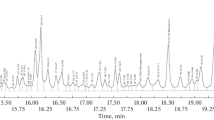Abstract
The new algorithm for evaluating the holdup time of gas-chromatographic systems (t 0) is considered. It is applicable at any temperature regimes of analysis not only isothermal, but also with linear temperature programming. It is based on the extrapolation of retention times of consecutive homologues (in particular, n-alkanes) with the evaluation of retention time of hypothetical homologue with zero number of carbon atoms in the molecule by using linear recurrent relations. It is shown that historically first method for evaluating t 0 using retention times (t R) of three consecutive homologues, proposed by Peterson and Hirsch (J Lipid Res 1:132–144, 1959), can be expanded onto temperature programming regimes after its modification by replacing t R values by their squares.




Similar content being viewed by others
References
Blumberg LM (2010) Temperature-programmed gas chromatography. Wiley, Weinheim
Scott RPW (2010) Dead point: volume or time, In: Cazes J (ed) Encyclopedia of chromatography, vol 1, 3rd edn. Taylor & Francis, Boca Raton, pp 557–558
Ettre LS (1980) Chromatographia 13(2):73–84
Jinno K (2010) Void volume in LC, In: Cazes J (ed) Encyclopedia of chromatography, vol 3, 3rd edn. Taylor & Francis, Boca Raton, pp 2430–2431
Alhedai A, Martire DE, Scott RPW (1989) Analyst 114(8):869–875
Parcher JF, Jonhson DH (1980) J Chromatogr Sci 18(6):267–272
Vezzani S, Castello G, Pierani D (1998) J Chromatogr A 811:85–96
Binder RB, Haddon WF (1984) Carbohydr Res 129:21–32
Oumada FZ, Roses M, Bosch E (2000) Talanta 53:667–677
Peterson ML, Hirsch J (1959) J Lipid Res 1:132–134
Harvey J, Gold US (1962) Anal Chem 34(1):174–175
Riedmann M (1974) Chromatographia 7(2):59–62
Lomsugarit S, Jeyashoke N, Krisnangkura K (2001) J Chromatogr A 926:337–340
Guardino X, Albaiges J, Firpo G, Rodriquez-Vinals R, Gassiot M (1976) J Chromatogr 118:13–22
Grobler A, Balizs G (1974) J Chromatogr Sci 12:57–58
Toth A, Zala E (1984) J Chromatogr 284:53–62
Toth A, Zala E (1984) J Chromatogr 298:381–387
Smith RJ, Haken JK, Wainwright MS (1985) J Chromatogr 331:389–395
Ballschmiter K, Heeg FJ, Meu HJ, Zinburg R (1985) Fresenius J Anal Chem 321:426–435
Touabet A, Maeck M, Badjah Hadi Ahmed AY, Meklati BY (1986) Chromatographia 22(7):245–248
Touabet A, Badjah Hadi Ahmed AY, Maeck M, Meklati BY (1986) J High Resolut Chromatogr Chromatogr Commun 8(9):456–460
Wronski B, Szczepaniak LM, Witkiewicz Z (1986) J Chromatogr 364:53–61
Vigdergauz MS, Petrova EI (1987) Russ J Anal Chem 42(8):1476–1481
Maeck M, Touabet A, Badjah Hadi Ahmed AY, Meklati BY (1989) Chromatographia 29(5/6):205–208
Quintanilla-Lopez JE, Lebron-Aguilar R, Garcia-Dominguez JA (1997) J Chromatogr A 767:127–136
Lebron-Aguilar R, Quintanilla-Lopez JE, Garcia-Dominguez JA (1997) J Chromatogr A 760:219–227
Garcia-Dominguez JA, Quintanilla-Lopez JE, Lebron-Aguilar R (1998) J Chromatogr A 803:197–202
Aryusuk K, Krisnangkura K (2003) J Sep Sci 26:1688–1692
Pous-Torres S, Torres-Lapasity JR, Garsia-Alvarez-Cogue MC (2009) J Liq Chromatogr Relat Technol 32:1065–1083
Wainwright MS, Haken JK (1980) J Chromatogr 184:1–20
Kaiser RE, Rackstraw AJ (1983) Computer chromatography, vol 1. A. Huethig Verlag, Heidelberg
Smith RJ, Haken JK, Wainwright MS (1985) J Chromatogr 334:95–127
Smith RJ, Haken JK, Wainwright MS, Madden BG (1985) J Chromatogr 328:11–34
Kaiser RE, Bertsch W (1998) J High Resolut Chromatogr Chromatogr Commun 1:115–120
Dominguez JAG, Diez-Masa JC, Davankov VA (2001) Pure Appl Chem 73(6):969–992
Wu NS, Wu GS, Wu MY (2006) J Chromatogr Sci 44(5/6):244–246
Curvers J, Rijks J, Cramers C, Knauss K, Larson P (1985) J High Resolut Chromatogr Chromatogr Commun 8:611–617
Golovnya RV, Svetlova NY (1988) Russ J Anal Chem 43(5):859–865
Golovnya RV, Svetlova NY (1988) Chromatographia 25(6):493–496
Zenkevich IG, Szczepaniak LM (1992) Russ J Anal Chem 47(3):507–513
Klemp MA, Sacks RD (1991) J Chromatogr Sci 29(12):507–510
Zenkevich IG (2006) Russ J Org Chem 42(1):1–11
Zenkevich IG (2006) Russ J Phys Chem 80(10):1636–1642
Zenkevich IG (2006) Russ J Gen Chem 76(11):1738–1741
Zenkevich IG (2006) Russ J Gen Chem 76(11):1742–1753
Zenkevich IG (2007) Russ J Struct Chem 48(6):1006–1014
Zenkevich IG (2008) Russ J Phys Chem 82(5):695–703
Zenkevich IG (2009) J Chemom 23:179–187
Zenkevich IG (2009) J Math Chem 46:913–933
Zenkevich IG (2010) J Chemom 24:158–167
Zenkevich IG (2011) Recurrent relationships in organic chemistry. In: Kostikov RR (ed) Contemporary problems of organic chemistry, vol 15. University Press, St Petersburg, pp 235–284
Zenkevich IG, Makarov ED (2007) J Chromatogr A 1150:117–123
Zenkevich IG (1984) Russ J Anal Chem 39(7):1297–1307
Zenkevich IG, Ioffe BV (1988) J Chromatogr 439:185–194
Zenkevich IG (2010) Kovats’ retention index system. In: Cazes J (ed) Encyclopedia of Chromatography, vol 2, 3rd edn. Taylor & Francis, Boca Raton, pp 1304–1310
Zenkevich IG (1995) Russ J Appl Chem 68(8):1321–1327
Author information
Authors and Affiliations
Corresponding author
Rights and permissions
About this article
Cite this article
Zenkevich, I.G. Evaluating the Holdup Time of Gas-Chromatographic Systems in Various Temperature Regimes by Using Recurrent Relations. Chromatographia 75, 767–777 (2012). https://doi.org/10.1007/s10337-012-2260-2
Received:
Revised:
Accepted:
Published:
Issue Date:
DOI: https://doi.org/10.1007/s10337-012-2260-2




